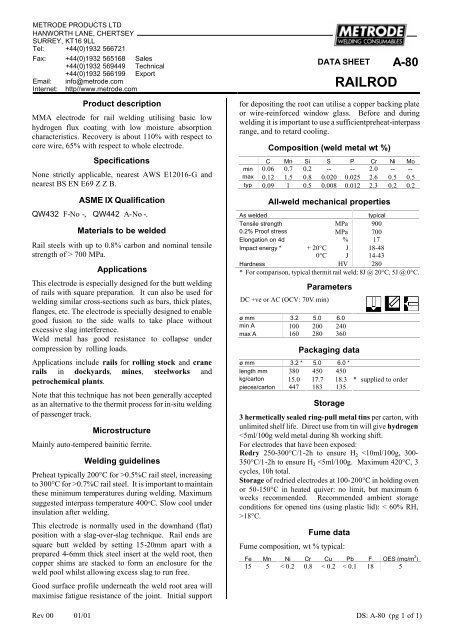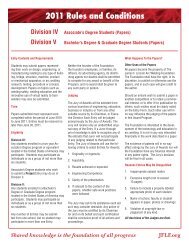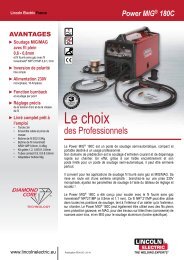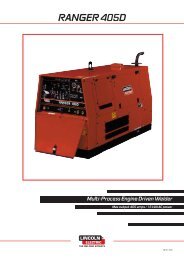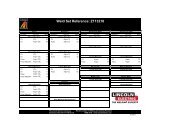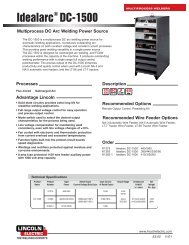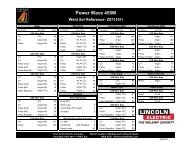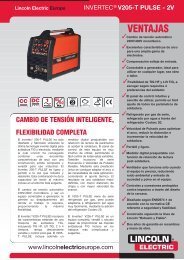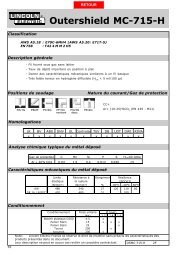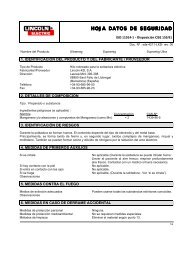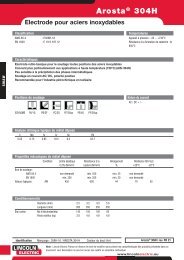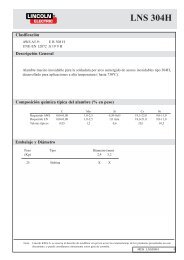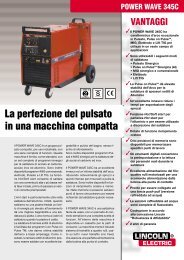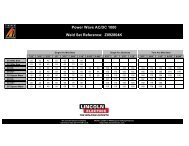Metrode Consumables Catalog
Metrode Consumables Catalog
Metrode Consumables Catalog
Create successful ePaper yourself
Turn your PDF publications into a flip-book with our unique Google optimized e-Paper software.
METRODE PRODUCTS LTD<br />
HANWORTH LANE, CHERTSEY<br />
SURREY, KT16 9LL<br />
Tel: +44(0)1932 566721<br />
Fax: +44(0)1932 565168 Sales<br />
+44(0)1932 569449 Technical<br />
DATA SHEET A-80<br />
+44(0)1932 566199 Export<br />
Email: info@metrode.com<br />
Internet: http//www.metrode.com RAILROD<br />
Product description<br />
MMA electrode for rail welding utilising basic low<br />
hydrogen flux coating with low moisture absorption<br />
characteristics. Recovery is about 110% with respect to<br />
core wire, 65% with respect to whole electrode.<br />
Specifications<br />
None strictly applicable, nearest AWS E12016-G and<br />
nearest BS EN E69 Z Z B.<br />
ASME IX Qualification<br />
QW432 F-No -, QW442 A-No -.<br />
Materials to be welded<br />
Rail steels with up to 0.8% carbon and nominal tensile<br />
strength of > 700 MPa.<br />
Applications<br />
This electrode is especially designed for the butt welding<br />
of rails with square preparation. It can also be used for<br />
welding similar cross-sections such as bars, thick plates,<br />
flanges, etc. The electrode is specially designed to enable<br />
good fusion to the side walls to take place without<br />
excessive slag interference.<br />
Weld metal has good resistance to collapse under<br />
compression by rolling loads.<br />
Applications include rails for rolling stock and crane<br />
rails in dockyards, mines, steelworks and<br />
petrochemical plants.<br />
Note that this technique has not been generally accepted<br />
as an alternative to the thermit process for in-situ welding<br />
of passenger track.<br />
Microstructure<br />
Mainly auto-tempered bainitic ferrite.<br />
Welding guidelines<br />
Preheat typically 200°C for >0.5%C rail steel, increasing<br />
to 300°C for >0.7%C rail steel. It is important to maintain<br />
these minimum temperatures during welding. Maximum<br />
suggested interpass temperature 400 o C. Slow cool under<br />
insulation after welding.<br />
This electrode is normally used in the downhand (flat)<br />
position with a slag-over-slag technique. Rail ends are<br />
square butt welded by setting 15-20mm apart with a<br />
prepared 4-6mm thick steel insert at the weld root, then<br />
copper shims are stacked to form an enclosure for the<br />
weld pool whilst allowing excess slag to run free.<br />
Good surface profile underneath the weld root area will<br />
maximise fatigue resistance of the joint. Initial support<br />
for depositing the root can utilise a copper backing plate<br />
or wire-reinforced window glass. Before and during<br />
welding it is important to use a sufficientpreheat-interpass<br />
range, and to retard cooling.<br />
Composition (weld metal wt %)<br />
C Mn Si S P Cr Ni Mo<br />
min 0.06 0.7 0.2 -- -- 2.0 -- -max<br />
0.12 1.5 0.8 0.020 0.025 2.6 0.5 0.5<br />
typ 0.09 1 0.5 0.008 0.012 2.3 0.2 0.2<br />
All-weld mechanical properties<br />
As welded typical<br />
Tensile strength MPa 900<br />
0.2% Proof stress MPa 700<br />
Elongation on 4d % 17<br />
Impact energy * + 20°C J 18-48<br />
0°C J 14-43<br />
Hardness HV 280<br />
* For comparison, typical thermit rail weld: 8J @ 20°C, 5J @ 0°C.<br />
DC +ve or AC (OCV: 70V min)<br />
Parameters<br />
ø mm 3.2 5.0 6.0<br />
min A 100 200 240<br />
max A 160 280 360<br />
Packaging data<br />
ø mm 3.2 * 5.0 6.0 *<br />
length mm 380 450 450<br />
kg/carton 15.0 17.7 18.3<br />
pieces/carton 447 183 135<br />
Storage<br />
* supplied to order<br />
3 hermetically sealed ring-pull metal tins per carton, with<br />
unlimited shelf life. Direct use from tin will give hydrogen<br />


